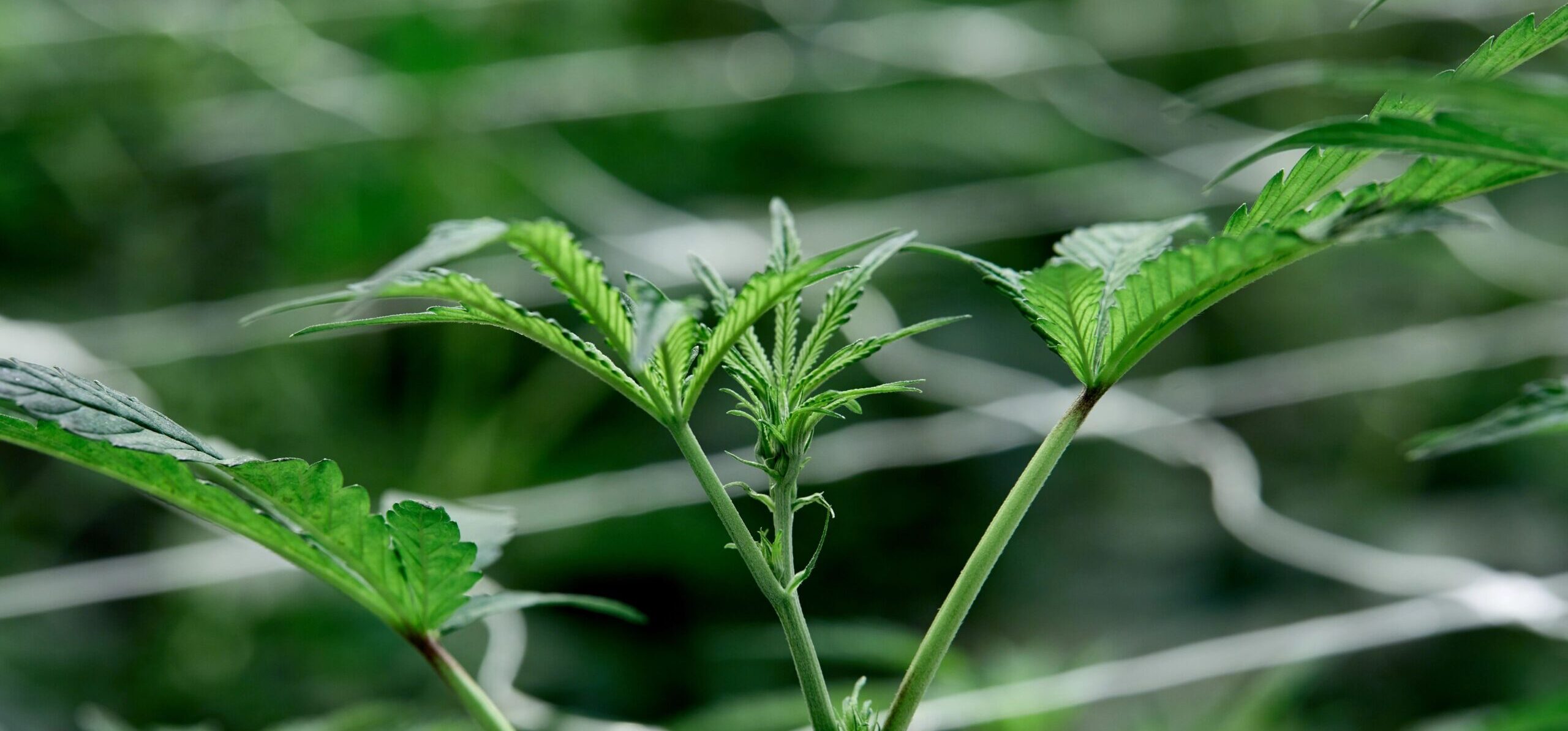Sea of green (SOG) and screen of green (ScrOG) are two popular and commonly used training methods in cannabis cultivation. While they share the same goal — increasing final yield — they go about it in different ways. Learn more about these growing techniques, their differences, and how they're used in cannabis cultivation.
Why use cannabis training techniques?
Before diving into the SOG and ScrOG techniques themselves, you might be new to cannabis training in general. Cannabis training includes a variety of techniques that are used to change or manipulate the natural growth of the plant.
Often, these techniques are used to maximize yield in the face of physical space constraints, a specific grow environment, or even for a specific cultivar. You can alter the plant's natural height, width, number of bud sites, or the distribution of the entire crop's canopy with such techniques, and when done with care, the plants can be quite receptive and adaptive to training.
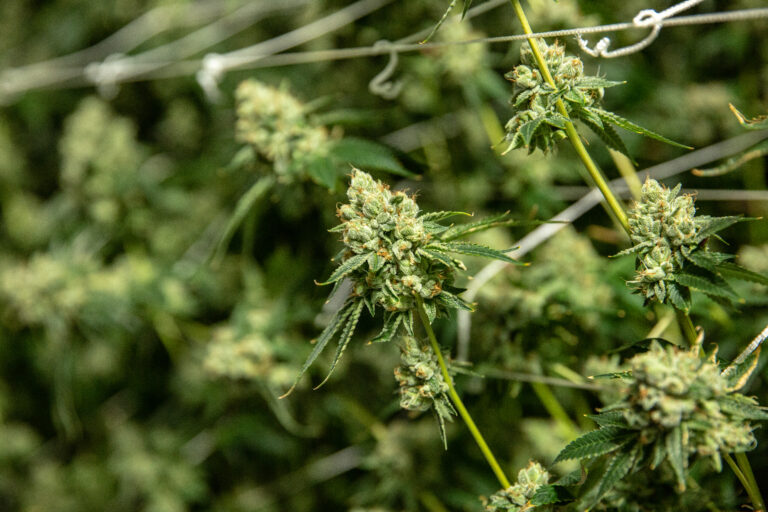 Photo by: Gina Coleman/Weedmaps
Photo by: Gina Coleman/WeedmapsImage lightbox

Training techniques are often grouped under two broad umbrellas, low-stress training, and high-stress training, based on how much physical stress they put on the plants. Low-stress techniques are about bending or guiding the plant's growth, whereas high-stress techniques may involve cutting, breaking, or otherwise wounding the plant to alter its growth.
While most low- and high-stress techniques are considered more advanced cultivation practices, both SOG and ScrOG are relatively simple to follow and a good way to get your feet wet if you're new to training.
What is sea of green?
Sea of green is a low-stress training technique that uses a short vegetative period and plant crowding to encourage vertical growth and the production of one main cola on each plant. This technique was developed by indoor cultivators to maximize yields in small spaces, where many small plants are clustered together under grow lights. As the plants grow together, they develop a dense canopy or a “sea of green."
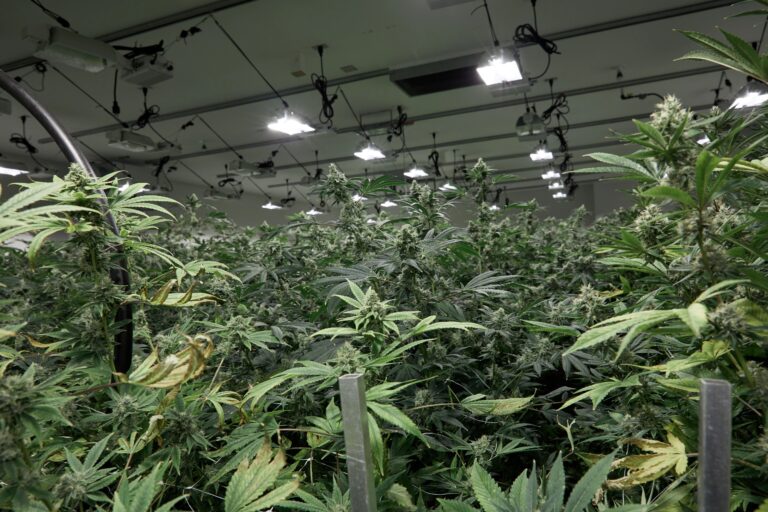 Photo by: Gina Coleman/Weedmaps
Photo by: Gina Coleman/WeedmapsImage lightbox

By giving plants a short or sometimes non-existent vegetative period before forcing them into flower, they stay relatively small and focus most of their energy on producing one main cola or bud site with the added advantage of a shorter overall life cycle. Sea of green is most often used with clones to accommodate the large number of plants needed and to ensure the plants exhibit similar growth traits in height and speed.
“Typically, plants are initiated into flower within two weeks of coming out of the clone dome and allowed to grow straight up rather than being trained or topped," explained Tim Nolan, Chief Operations Officer at Copperstate Farms. “You typically see a high yield per square foot and a low yield per plant with this methodology. It is a great way to maximize your yields if you have limited space for a veg room and want to maximize the number of flower cycles per year."
Pros and cons of the sea of green method
While a high density of plants can pose specific challenges around pest and disease management and day-to-day maintenance, for commercial growers and home growers who aren't constrained to a small number of plants, SOG offers a quick and easy way to increase yields and optimize small grow spaces.
Pros
- Faster crop cycles
- Maximizes yield in small spaces
- Well-suited to smaller and shorter indica plants
- Low crop height can lend itself to vertical stacking of multiple grow levels
Cons
- Requires tight environmental controls and regular monitoring to maintain plant health and avoid disease and pests
- Such outbreaks can be harder to spot, spread quickly, and are more challenging to contain
- Challenging to reach individual plants
- General maintenance, such as watering and pruning, requires more time and care
- Requires a higher investment in clones or seeds
What is screen of green?
Screen of green is another low-stress training technique that uses physical manipulation of the plant's development to produce horizontal growth with several colas per plant. As compared to SOG, ScrOG uses far fewer plants but aims to increase yield by training plants out of their natural shape to grow several horizontal branches, each with its own cola. When left to grow naturally, cannabis plants develop into a “Christmas tree" shape — called "apical dominance" — with bushier bottoms narrowing into a single elongated cola at the top.
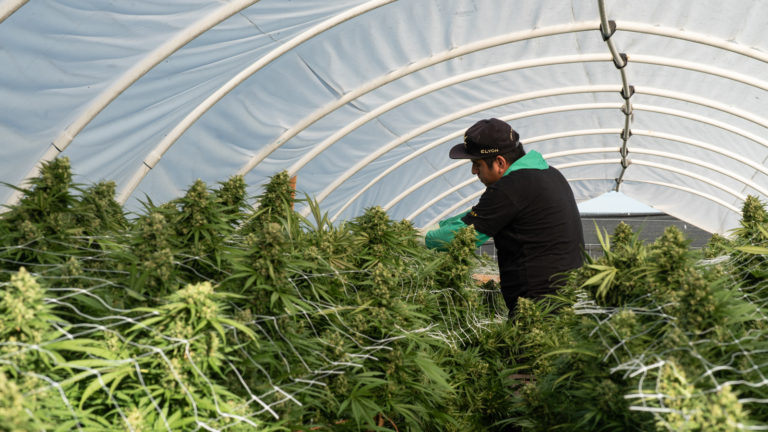 Photo by: Damien Robertson/Weedmaps
Photo by: Damien Robertson/WeedmapsImage lightbox

“Screen of green is a way to maximize yields while using the minimum number of plants," explained Nolan. “[This technique] uses topping, trellis, or stakes to train cannabis plants to grow horizontally and occupy large amounts of space in flower. If you are indoors, a longer vegetative period of growth is required before the flower cycle is initiated. Some growers will use the high-stress technique of topping to encourage more vigorous growth in the plant's side branches. While topping and ScrOG work well together, you can successfully use ScrOG without topping your plants.
ScrOG gives the plants ample time in the vegetative phase to be trained through the screen and to horizontally fill out the canopy before flowering. Once the screen of green has been filled out, bud sites are in an optimal setup for maximum light exposure during flower.
Pros and cons of the screen of green method
Using ScrOG means more hands-on care while training the plant through the screen. It often involves a longer than average vegetative period, which means fewer harvests overall. But for growers who are limited to a small number of plants and willing to invest the time and energy into a ScrOG grow, you can be rewarded with hefty yields per plant.
Pros
- Maximizes yields for home growers who have legal limits on the number of plants they can grow
- Well-suited to the generally taller and branchier sativa cultivars
- Well-suited to grows with restricted vertical space
- Requires a lower average investment in clones or seeds
- Offers a high level of control on plant height and light exposure
Cons
- A long and sometimes extended vegetative phase of growth
- Requires more initial setup
- Requires regular manipulation of the plants while actively training
- Poor performance from just one plant can make a big difference in the final yield
- Plants cannot be easily moved in this setup
Sea of green vs screen of green: what's the difference?
Both methods are headed to the same destination: more bud on harvest day. They just get there in different ways.
- SOG encourages plants to focus energy on upward growth and development of one cola, and packing more plants into a given grow space increases yield.
- ScrOG gives plants more time to develop in the vegetative phase and uses physical manipulation during that time to encourage horizontal growth and the development of more colas, which increases yield.
“One [sea of green] is a way to maximize yield per square foot, and the other [screen of green] is a way to maximize yield per plant," said Nolan. “Surprisingly, both techniques have similar outcomes when done properly."
Points of comparison
- Cycle length: SOG utilizes shorter grow cycles, while ScrOG utilizes longer grow cycles.
- Number of plants: SOG aims for high plant numbers, whereas ScrOG aims for fewer. “SOG is generally more dense, with up to 16 plants per square meter, whereas ScrOG is less dense, with 1 - 4 plants per square meter," said Mohammed Korched, Cultivator for Bombatta.
- Plant size: SOG keeps plants relatively small and compact, whereas ScrOG encourages plants to develop many branches and spread out.
- Yield per plant: SOG aims for a small yield per plant with many plants, whereas ScrOG aims for a high yield per plant but with fewer plants.
- Setup: SOG is a relatively easy setup, ScrOG requires the proper setup of the screen.
- Maintenance: While ScrOG plants need to be “woven" or “tucked" into the screen regularly during vegetative growth, SOG is generally considered higher maintenance since environmental parameters need to be watched closely, and plants need to be pruned and spot-checked for pests and diseases regularly.
Sea of green vs screen of green: which is better?
There is no wrong answer since both can be used effectively to improve yields. You can select either SOG or ScrOG based on the details of your grow, including the space you have to work with, the cultivar you want to grow, and the legal limit on the number of plants you can grow depending on where you live.
 Photo by: Gina Coleman/Weedmaps
Photo by: Gina Coleman/WeedmapsImage lightbox

“It is important to note that both techniques require careful monitoring and management of plant growth and environmental conditions to achieve the best results," said Cody Bourget, the Director of Farming Operations at Cultivatd.
FAQs
Which method is more suitable for indoor growing?
Both the sea of green and the screen of green can be used with great success in indoor growing environments. “Both techniques are well-suited for indoor growing, but the sea of green is often preferred for its simplicity and faster turnaround time. Screen of Green requires more training and maintenance but can result in higher yields per plant," said Bourget.
Which method is more suitable for outdoor growing?
SOG requires specific environmental controls over space and light that it would be hard to replicate outdoors, and it is a training technique that was, in fact, developed for indoor growing.
“On the other hand, outdoor cultivation generally allows for more space and light, making ScrOG a viable option," said Korched. “The longer stems and branches of SCROG plants can make them better suited to outdoor growing, where they have more room to spread horizontally." While SCROG is more often used in and associated with indoor grows, it can be used successfully outdoors and may be a good option if home growers would like to keep plants smaller in size and less noticeable.
How do you set up a sea of green system?
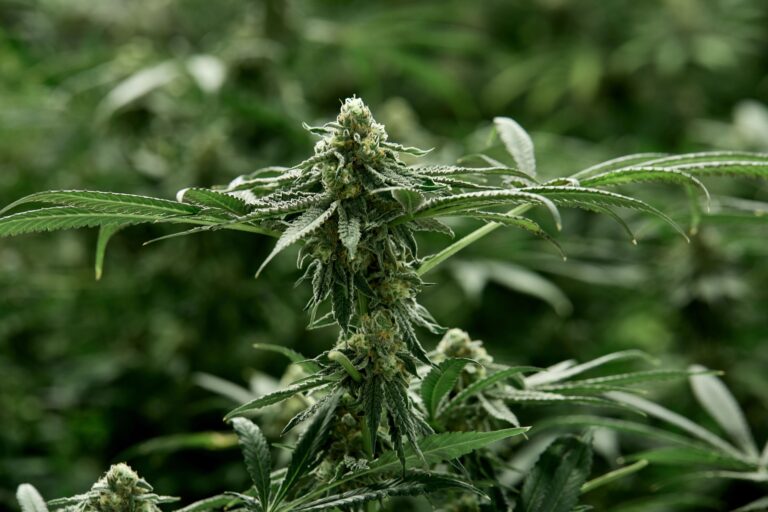 Photo by: Gina Coleman/Weedmaps
Photo by: Gina Coleman/WeedmapsImage lightbox

The main steps in setting up a successful SOG system include:
Step 1
Source plants and containers. “To use the SOG method, growers typically start with small clones or seedlings and place them in small pots or containers," said Korched. Do some calculations as to the number of plants and size of the pot you could accommodate in your grow room. Most SOG growers aim for 9 - 16 plants per square meter of space.
Step 2
Ensure you have proper light. Ideally, lighting should reach all four corners of the grow space.
Step 3
Pack the plants into the grow space. “This creates a dense canopy of leaves that blocks out most of the light, encouraging the plants to grow tall and thin as they compete for light," said Korched.
Step 4
Decide when to begin bloom. With clones, they may need time to fully root before being forced to bloom. With plants from feminized seeds, bloom can begin immediately or within a week or so of germination.
Step 5
Carefully maintain your grow. “To maintain the SOG setup, growers must regularly prune and train the plants to ensure they grow evenly and don't become too tall or bushy," said Korched. “Carefully monitor the plants for signs of nutrient deficiencies or pests, as the dense canopy can make it difficult to spot problems early on."
How do you set up a screen of green system?
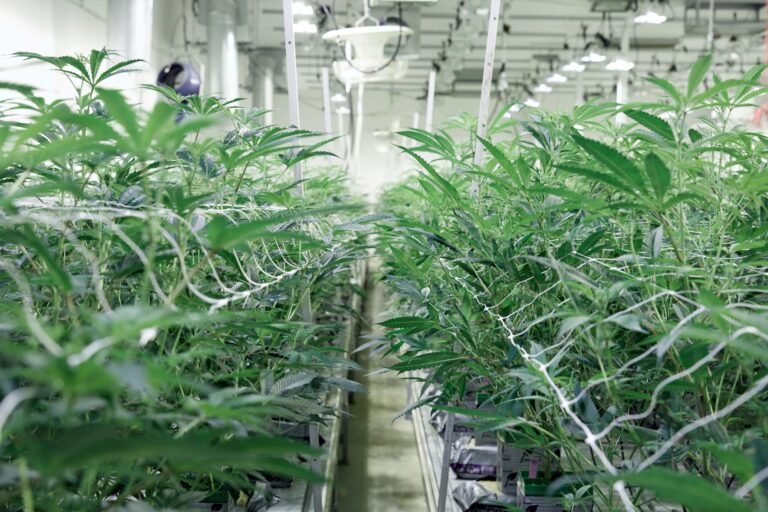 Photo by: Gina Coleman/Weedmaps
Photo by: Gina Coleman/WeedmapsImage lightbox

The main steps in setting up a successful ScrOG system include:
Step 1
Source plants and containers. With ScrOG, there is more flexibility as to the number of plants you grow, but given the longer veg phase, you will need larger pots to accommodate.
Step 2
Ensure you have proper light. Lighting is equally important to ScrOG grows. When using ScrOG indoors, lighting will need to reach all four corners of the grow space. Consider leaving some space to move the light up if plants grow taller than expected.
Step 3
Set up your ScrOG screen. You can either make your own screen or buy a ready-made ScrOG screen. Many ScrOG growers used a screen with 3 - 4" sized squares. Depending on your growing space, screens could be attached to the sides of a tent, or you could use steaks or other poles to suspend the screen. Aim for about one foot above the base of the plants.
Step 4
Weave your plants into the screen. “As the plants grow, the stems and branches are gently trained to grow through the holes in the screen, allowing them to spread horizontally," said Korched. Try to fill each square with a branch, but do not break a branch to reach a square. Keep weaving every few days throughout the early flower phase until your screen is full. Secure branches with plastic ties.
What strains are best suited for the sea of green method?
Generally, SOG works best with plants that produce fewer lateral (side) branches and produce one dominant cola. Indica and indica-dominant hybrids often exhibit these traits, but any strain can be grown in a SOG setup.
“Sea of green can work with most genetics but can be challenging for strains that stretch more than three times in flower," added Nolan. Strains like GG4, White Widow, and Northern Lights have been reported to work well with SOG.
What strains are best suited for the screen of green method?
In contrast, ScrOG is best suited to plants that produce a lot of lateral branches. While sativa and sativa-dominant hybrids are most likely to have these traits, lateral branching can be encouraged in any strain by topping your plants.
“Vigorous genetics that are easily trained and stretch a lot in flower are best suited for ScrOG," said Nolan. Jack Herer and Haze strains have been reported to do well with ScrOG.
Bottom line
Both the sea of green and the screen of green training methods can be used with great success when growing cannabis, though each takes time and effort to become proficient. With its own pros and cons, both SOG and ScrOG can increase yields and take your cultivation prowess to the next level.
Experiment with both and see which best suits your growing style and preferences. Happy training!
Written by Lauren Wilson | Featured image by Gina Coleman

